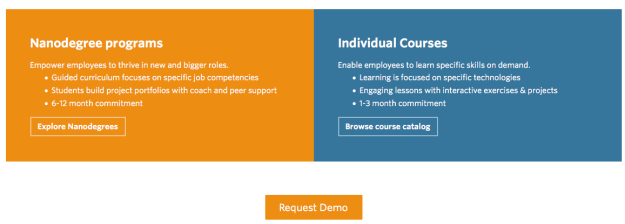This is a special issue of the ‘Need-to-Know’ blog post series featuring the latest developments in Massive Open Online Courses (MOOCs) offered by providers: Coursera, iVersity, edX, and Udacity.
 1. Coursera’s Business Model Taking Shape
1. Coursera’s Business Model Taking Shape
Coursera is finding its niche and business model. The MOOC provider is moving towards three revenue-generating strategies: 1) fee-based courses which require students to pay a fee for access to graded assignments, 2) Specializations, a sequence of courses with a capstone project, and 3) Course Certificates (formerly known as Signature Track).
Signature Track, launched in 2013 was Coursera’s first (significant) revenue generating strategy. Students paid a fee in exchange for the opportunity to earn a verified certificate. Initially only a handful of courses featured the certificate option. Signature Track has since expanded, had a recent name change to Course Certificate and features a flat fee of $49. The Course Certificate option is now available across numerous courses. Revenue estimates suggest Certificates generated between $8 and $12 million in 2014 (Shah, 2014).
Specializations feature a sequence of courses (typically four to six) with a capstone project where students apply the skills learned in order to earn a certificate. Launched two years ago, the program appears successful given the number of Specializations offered—in the hundreds according to Coursera. Fees range between $300 and $600. Tuition is determined by the price of each course (which range between $39 and $79), the number of courses within each, and the fee for the capstone project. If there is even modest student demand for Specializations as Coursera founder Daphne Koller indicates, revenue opportunity is significant (Bogen, 2015).
The Purchase Course strategy announced last week requires that students pay to gain access to graded assignments. There is an option to ‘audit’ the course where students have access to course materials only. An excerpt from Coursera’s blog (below) outlines the strategy:
Starting today, when you enroll in certain courses, you’ll be asked to pay a fee (or apply for Coursera’s financial aid program) if you’d like to submit required graded assignments and earn a Course Certificate. You can also choose to explore the course [audit] for free, in which case you’ll have full access to videos, discussions, and practice assignments, and view-only access to graded assignments. — Coursera Blog, January 19, 2016
This format is similar to what’s offered at iVersity, a Europe-based MOOC provider. Tuition at Coursera ranges between $39 and $119 per course. Below is a screen shot showing the options presented to students enrolling for a course on Coursera’s platform.

Fee-based courses appear linked to courses that are part of the Specializations programs. The screenshot above is an image of what is presented when enrolling for ‘Understanding Financial Markets’
- Coursera is now offering a ‘Specialization’ program for professional learners (2014), Christina Farr, Venture Beat
- Financial Aid, Coursera Help Center
- Master New Skills in 2016 — 35+ Specializations Now Open, Coursera Blog
2) iVersity’s Pay-for Certificate Program & Udacity’s Nanodegree Plus
iVersity, one of Europe’s MOOC platforms launched it’s own version of Coursera’s Specializations—The Business Communication Programme. It’s targeted to working professionals seeking skills in business communication and marketing. It’s iVersity’s first venture into bundled programs. Yet the Programme is more similar to Udacity’s new Nanodegree Plus program, given it offers enhanced customer service—support and resources to help students find a job.
Udacity’s program goes further by guaranteeing that students find a job within six months, or their money back. Fees at Udacity are monthly—$299. With an estimated program length between six and eight months that brings the cost between $1,794 and $2,392. iVersity’s tuition model takes a different approach but the price is similar (see screenshot below)—iVersity’s Programme at its regular price is $1,704 (approximate US funds), and the enhanced model is $2,611.

Screenshot above: Prices for iVersity’s ‘Business Communication Programme’ as displayed on the webpage at iversity.org. Sales prices still appear on site, February 2, 2016
iVersity also offers corporate learning services to companies looking for support in creating their own professional development courses. It’s promoted on their site as “a new form of professional development“.
- Nanodegree Plus, Udacity
- The Business Communication Programme, iVersity
3) Udacity for Business
Udacity also targets the corporate training market (tech-companies specifically) via its business webpage promoting “Hands-on Training. Done Online”. The courses and programs promoted are identical to Udacity’s existing ones, but are packaged to appeal to company and human resource executives as a solution to meet skill gaps among employees and as a tool for succession planning. Screenshot below from Udacity’s site:
 4) edX CEO: “edX offers complete programs online, not just individual courses“
4) edX CEO: “edX offers complete programs online, not just individual courses“
EdX, an open source platform and one of the few non-profit MOOC providers, also has revenue generating strategies, though not for profit. The strategies are needed to support edX’s goal of sustainability in order to achieve its mission of offering “access to high-quality education for everyone, everywhere”. Some of edX’s programs are similar to Coursera and Udacity—certificates with fees typically of $50 per course. Another is the XSeries program, a group of bundled courses. Students receive a Xseries Certificate upon completion, though unlike Coursera’s Specializations or Udacity’s Nanodegree, there is no final or capstone project. Another revenue strategy is licensing edX courses to countries such as China, India, France, the Middle East who have adopted Open edX (Young & Hobson, 2015).
EdX also offers Professional Education Courses targeted to students looking for skills training and professional development. Courses are stand-alone and online, some are self-paced and others have a start and end date that span between four and six weeks. Fees can be hefty, ranging between $89 and $949, as this one “Yield Curve Analysis”.
- edX now offers complete programmes online, not just individual courses: CEO Anant Agarwal (2016), Rica Bhattacharyya, The Economic Times
- EdX CEO Lays out Disruptive Vision for Higher Ed (2015), Here & Now, NPR
Insight: Offering free, high-quality content on feature-rich digital platforms is not free for the MOOC provider or the partnering institutions. Even though free appeared to be the end-goal of MOOCs at the time of their launch in 2012. But free is not sustainable. The concept of MOOCs is shifting to where the demand is—fee-based certificate courses and programs in skill-specific areas, and corporate learning. In between are programs offering MOOCs for higher education credit, as with courses for ECTS credit at iVersity, edX’s Global Freshman Academy, and Malaysia’s national credit recognition policy for MOOCs. Even degrees (Georgia Tech’s CS Master’s degree) and mini-degrees based on MOOCs as with MIT’s Micro-Masters. There still are courses for free for the life-long learner, like myself, looking for high quality, online courses not for credit. I view this as a win-win-win for everyone; the platform providers, the institutions and the students. Who says MOOCs weren’t disruptive?
Further Reading:
- Use of MOOCs and Online Education is Exploding: Here’s Why (2015), John Bersin, Forbes
- The Limits of Open (2016), Carl Straumsheim, Inside Higher Ed
- Free to Profit (2013), Ry Rivard, Inside Higher Ed
- Coursera flipped the classroom, but can it turn a profit? (2015), Miranda Bogen
Debbie, this is another great post of an amazing blog. Thank your that.
I was wondering if you have any information on the industry size for the last couple of years for MOOCs (or Online Learning in general). I was thinking about number of registered students, number of finished courses, revenue of the different platforms or even a breakdown of the education industry between face-to-face program, distance programs and mixed ones.
I have the hypothesis that the digitalization of the different activities we do everyday is not growing as fast in education as it did in others.
All the best, Sebastian
LikeLike
Thanks for the information. Great information.
I am curious how much the various platforms are missing in revenues by not somehow appealing to the more casual lifelong learners such as myself. I have no interest in certificates, diplomas, or whatever, but do want to financially support quality offerings. To that end I have paid for three certificates on the Future Learn platform simply because I was very impressed with the MOOC offering and thoroughly enjoyed the experience. I made that decision after completing the course.
Based on my experience with both Coursera and Iversity, I am not inclined to pay upfront for a course because of the uneven quality of the offerings.
Given the demographics of who is enrolling in MOOCs, I am left to think that the various platforms are leaving money on the table by not appealing to the lifelong learner who is simply after a quality experience.
LikeLike
Excellent point since several studies I’ve come across suggest that many MOOC students are just that–life-long learners who are taking the course out of personal interest. This group appears significant, and due to the demographic, would be (in most cases) able and willing to pay a nominal fee for access to quality learning opportunities. I’m taking a course through Stanford right now, International Women’s Health and Rights, on Stanford’s open learning platform Lagunita; the course is excellent. There is opportunity to sign up for a certificate which I will do (it’s into the second week now) given the high quality of the course. I would imagine, as you suggest, there is some way for MOOC -providers to take advantage of this segment.
LikeLiked by 1 person
Pingback: Need-to-Know MOOC News: The MOOC Business Model Gets Teeth in 2016 | AER Teaching